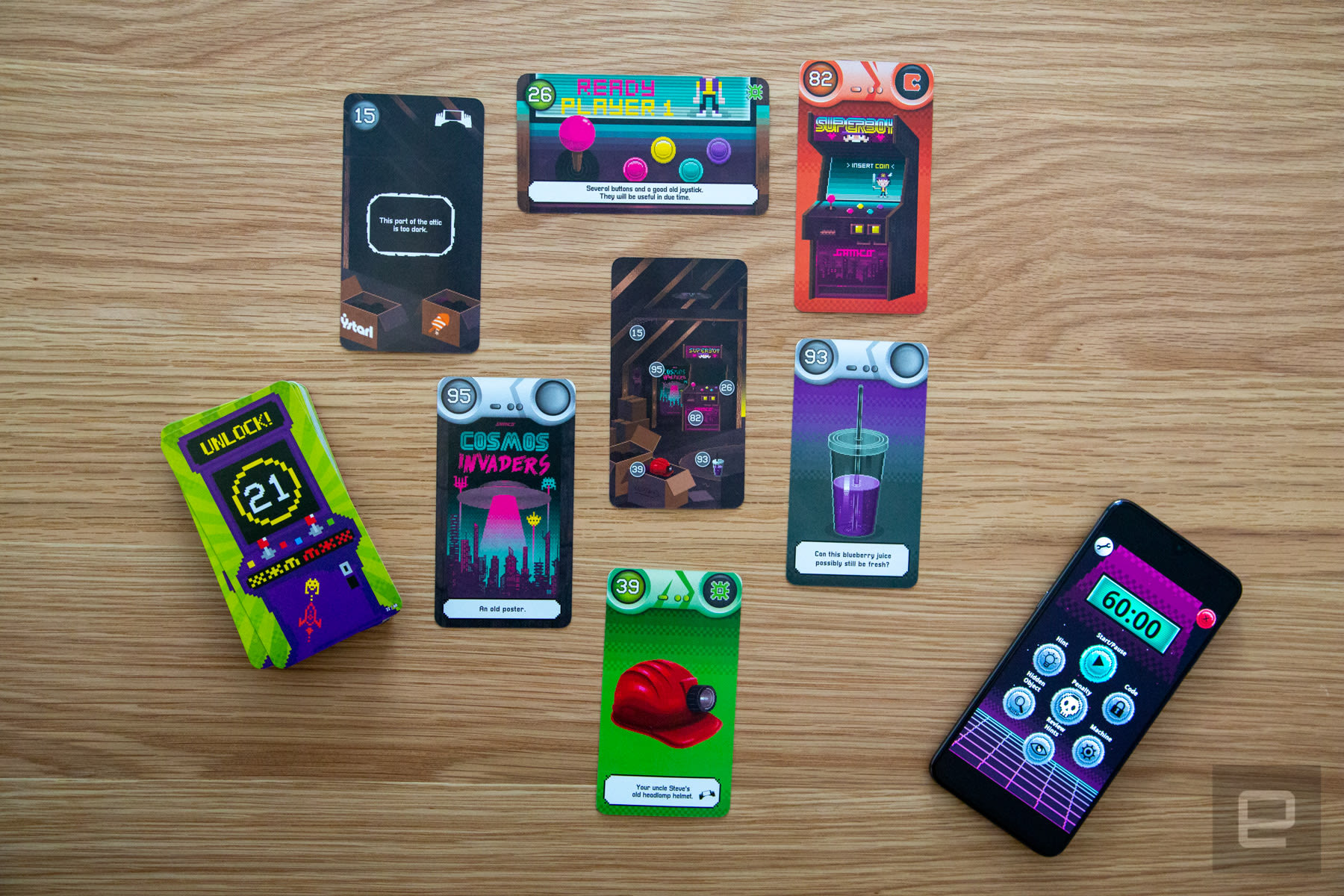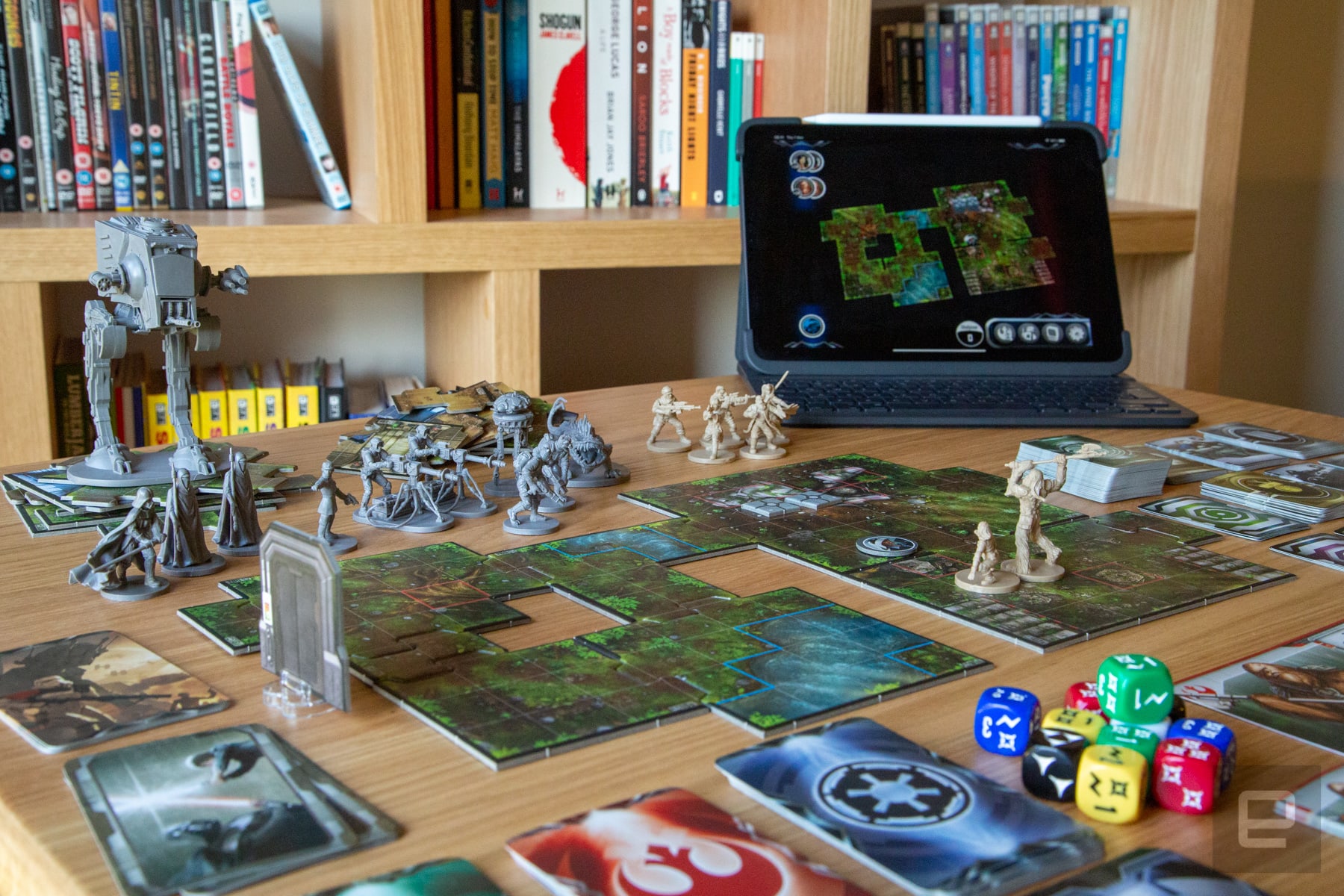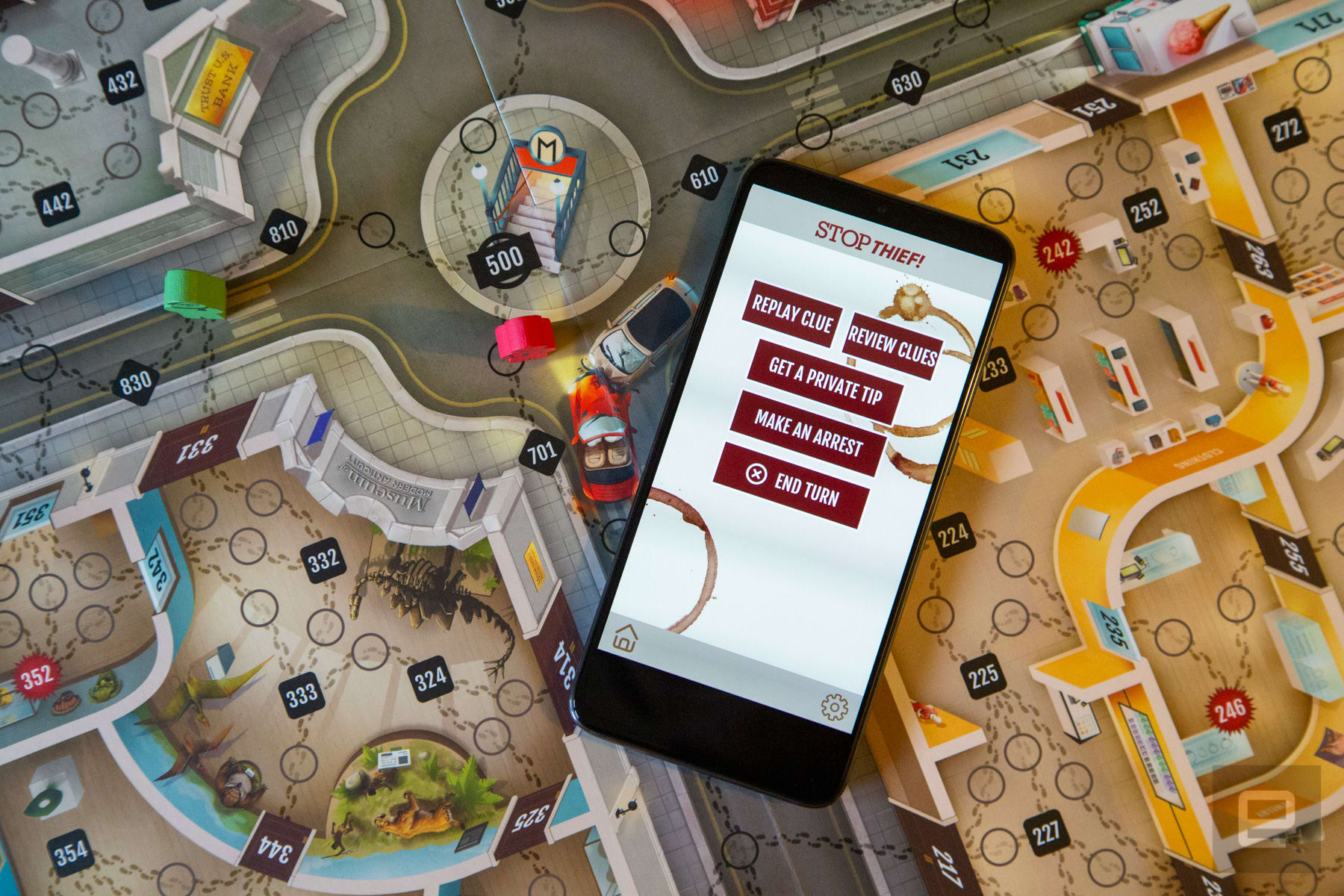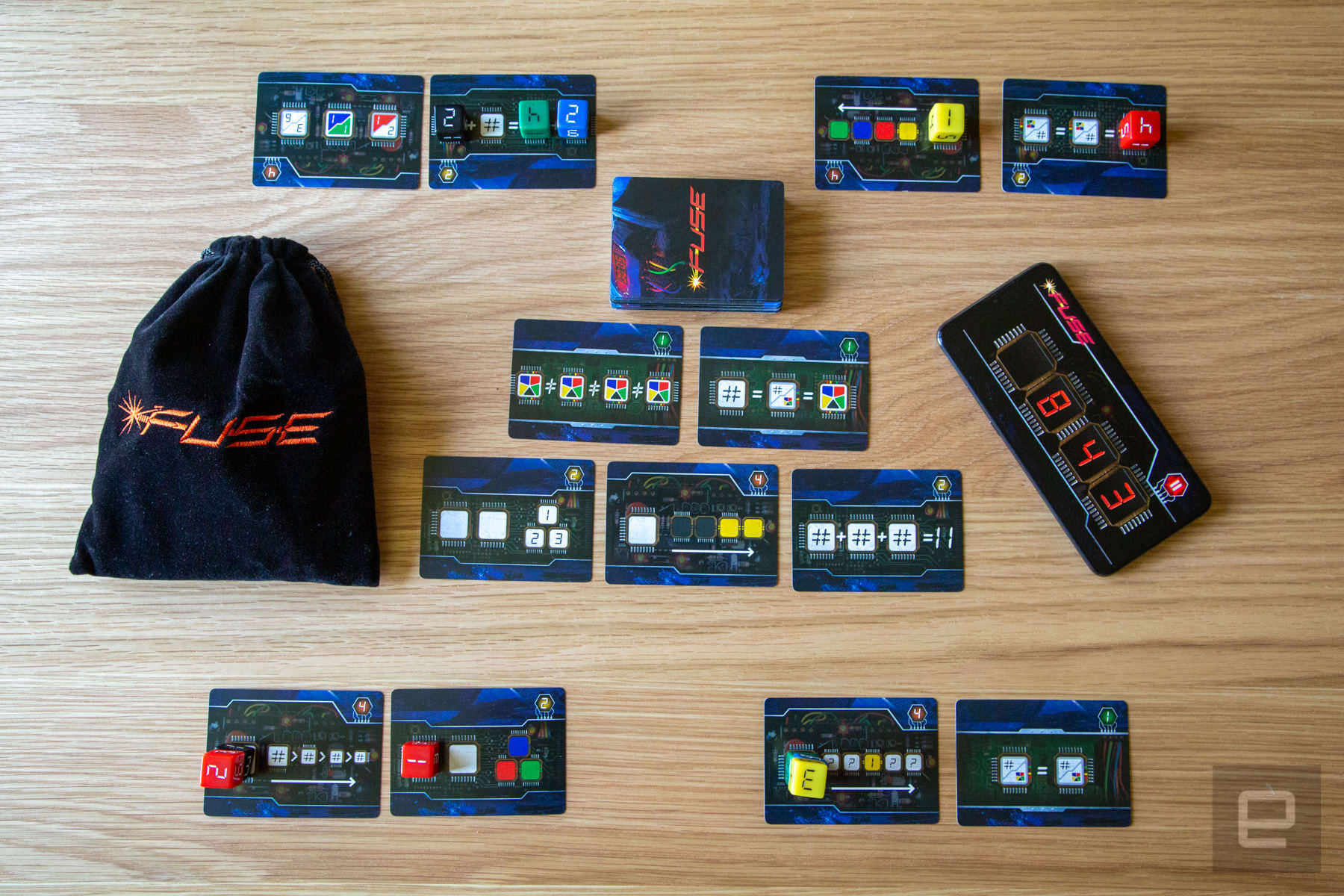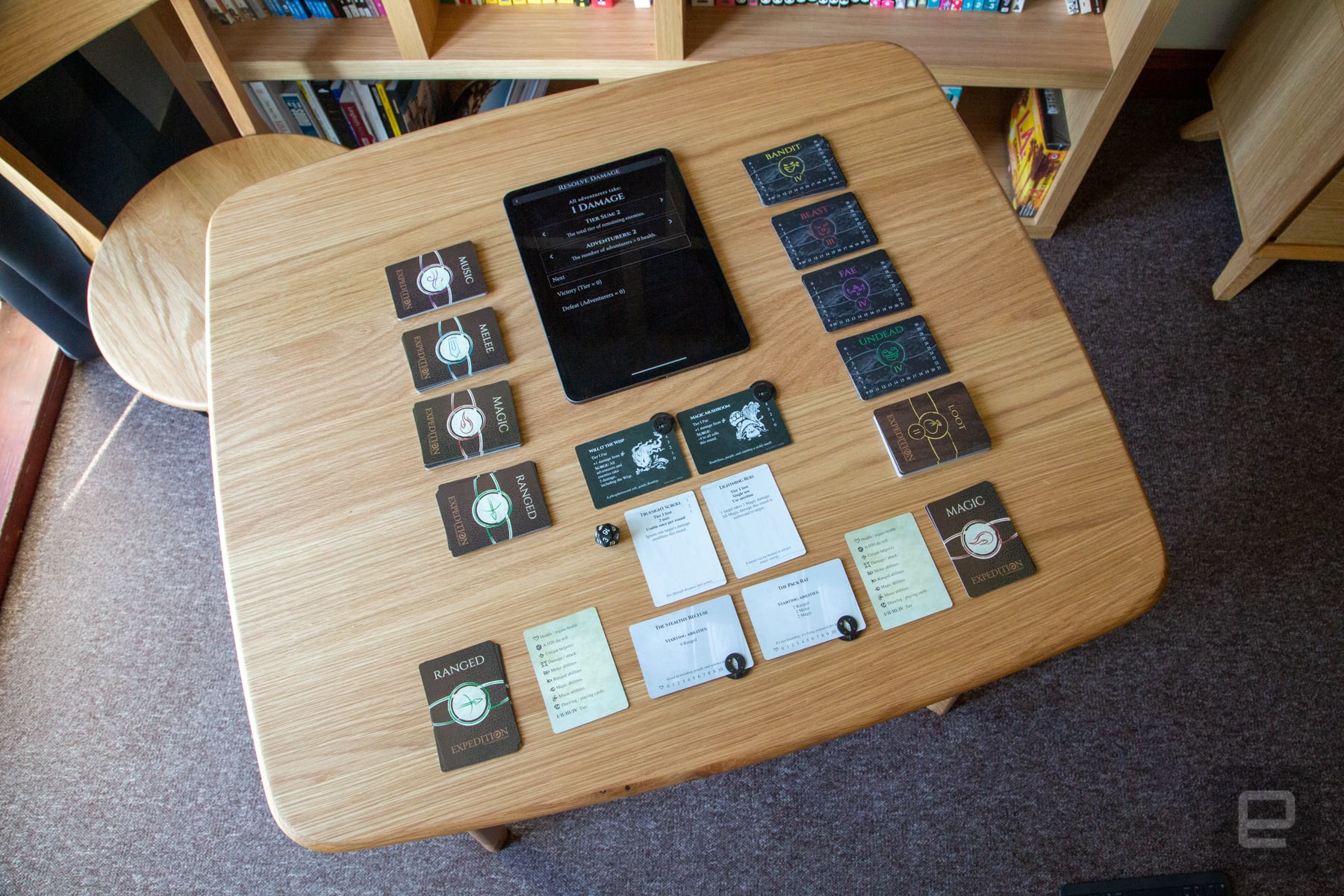One Night Ultimate Werewolf
- Players: 3–10
- Game time: 10 minutes
- Difficulty: Easy
One Night Ultimate Werewolf is a short and easily explained game about lying and persuasion. At the start of the game, players are given a random card with roles like Villager, Insomniac and Werewolf. They look at their cards in secret, close their eyes and wait for instructions from the companion app. During the “night” phase, the software will ask select players to open their eyes and utilize a special power — the Troublemaker can swap the cards of two other players, for instance. At the end of the “night,” the group has a few minutes to figure out who had what role and, ultimately, who now holds the Werewolves cards.
If humans choose the Werewolves correctly, they win. It’s up to the Werewolves, therefore, to interject during the discussion and lie in a way that shifts the group’s suspicion elsewhere. Speak too soon and you might say something that can be easily disproved by multiple “human” players; stay silent and the group will realize that you’re stalling and don’t know what’s safe to say. If you’re throwing a party and want something simple that will leave everyone howling with laughter, this is it. Publisher Bézier Games has developed alternative versions with vampire, alien and superhero themes as well as a Daybreak edition that can be played on its own or combined with the original Ultimate Werewolf game.
Unlock
- Players: 1–6
- Game time: 60 minutes
- Difficulty: Easy or hard, depending on the version you choose to play
Unlock is a card game series inspired by escape rooms. Every game, or deck, starts with a card that shows the place you’re stuck in: an office, perhaps, or an attic with a dusty arcade cabinet. The picture will usually show a series of numbered objects that correspond to cards in the deck. You fish those out and inspect them for additional numbers, which provide more cards or some way to combine them. Think that key (No. 11) works with the cabinet (No. 35)? Search the deck for No. 46, and if it’s there, flip the card over to see if you’re right.
The visual puzzles slowly grow in complexity. Maybe one card has a pattern that corresponds to a diagram in another. Or should it be angled and placed over another card somehow to reveal something entirely different? You have a 60-minute time limit that’s tracked with a companion app for iOS and Android. The software is also used to enter codes that you’ve figured out, ask for hints and occasionally deploy augmented reality to reveal hidden card details. Every deck, or “escape room,” has a single solution, so there isn’t much replay value. Most come in a triple pack, at least, with varying difficulty levels to ensure the fun lasts longer than a single night.
Clank! In! Space!
- Players: 1–4
- Game time: 45–90 minutes
- Difficulty: Medium
Get in. Get out. Clank! In! Space! is a deck-building board game that challenges players to explore the evil Lord Eradikus’ spaceship and steal as much loot as possible. At the start of your turn, you draw five cards that have different boots, blade and experience point totals. Boots let you move around the board and get closer to the “artifacts” that are necessary to win the game. Points and blades, meanwhile, let you buy better cards and vanquish foes that sit in a small Adventure Row beside the board. Once a card is taken from this repository, it’s replaced by a new one from the main Adventure Deck.
The app will guide you through the initial setup and add a mini boss that reacts to specific player milestones.
Some of your starter cards force you to create noise, or “clank,” however. These colored cubes are added to a black bag that also contains some harmless black cubes. If a card appears in the Adventure Row with the Boss Attack symbol, you have to reach into the bag and grab a number of cubes that’s dictated by how many people are playing. If any of your colored cubes are taken out, your character must suffer the same amount of damage. As the game wears on, Eradikus moves along a Rage Track that increases the number of cubes you have to pick out of the bag and how many Bounty Hunter cubes — which deal damage to everyone and stay in the bag for the rest of the game — are in play.
It’s a battle, therefore, to build up your personal deck and grab the artifacts before Lord Eradikus climbs up the rage track and starts dealing potentially lethal damage. An optional app will guide you through the initial setup and add a mini boss that reacts to specific player milestones. The software is also required if your friends aren’t available and you want to play through a five-part campaign solo. The game is better with friends — half the fun is discovering who, if anyone, is going to be hit by the next Boss Attack — but the single-player mode is still worth checking out if you want to familiarize yourself with the rules or try out some new strategies.
Star Wars: Imperial Assault
- Players: 1–5
- Game time: 60-120 minutes
- Difficulty: Hard
Imperial Assault isn’t the kind of game you can dig out and force random family members to play over the holidays. It’s a complex role-playing game with more than 30 figures, 10 dice, a dozen different card types and tokens that represent damage, fatigue, crates and computer terminals. Like Mansions of Madness — another top pick from publisher Fantasy Flight Games — Imperial Assault is built around a pile of double-sided tiles that can be flipped over and slotted together to create different maps. Movement, attacking with sight lines, strain and endurance — there’s a lot to learn, and you’ll need at least an hour to read the game’s many instructional booklets.
But if you love Star Wars or serious role-playing games, trust me: It’s worth it.There are three ways to play Imperial Assault. The first is the main campaign mode, which pits up to four people, each playing a different Rebel Alliance hero, against a player-controlled Galactic Empire. Alternatively, the heroes can play against the computer in a tweaked cooperative mode that uses a free companion app. The final way to play is a two-player skirmish mode that trades story-driven role-playing for tense, competitive combat. The cooperative mode is our favorite because it supports both solo and group play. The app is thoughtfully designed and guides you through individual missions as well as the character upgrades, armory purchases and side quests available in between.
Beasts of Balance
- Players: 1–6
- Game time: 30 minutes
- Difficulty: Easy
Back in 2016, I described Beasts of Balance as “Jenga evolved.” The game comes with a circular plinth and plastic “artifacts” that include geometric animals, elemental orbs and white, cross and arrow-shaped pieces. These objects contain NFC tags that are read by the podium and reflected inside the companion app. Play the octopus piece, for instance, and it will appear inside your virtual ocean with a few tantalizing points. Unfortunately, the creature’s value will deplete and eventually disappear unless you boost it with an elemental orb or create something completely new with the “cross” and “migration” artifacts.
You can play the game solo or with a group of friends, taking turns to select and place the colored pieces. Inevitably, your column of precarious blocks will wobble and crash to the floor. The game isn’t over though! If you can reassemble the tower before a nearby volcano erupts, the world will turn a blind eye and let you keep playing. That gives you another chance to set a high score or expand the app’s Pokédex-style Bestiary.
Since the game’s original release, creator Sensible Object has updated it with optional beasts, an augmented reality mode and a competitive multiplayer battles. The company was acquired by Pokémon Go developer Niantic a few months ago, however, and has stopped actively working on the game. But it’s still being sold, and the company promised in a blog post that basic customer service and app maintenance “will continue.” If and when that changes, we’ll be sure to let you know. For now at least, Beasts of Balance still feels like a safe purchase.
Stop Thief
- Players: 2–4
- Game time: 30–45 minutes
- Difficulty: Easy
Back in 1979, rocket scientist Robert Doyle made a board game called Stop Thief that challenged players to find invisible crooks across four large buildings. An electronic Crime Scanner, which resembled an old telephone, would issue a sound at the start of every turn that explained if the thief was walking across a floor, opening a door or breaking a window. “Investigators” used the order of these sounds to narrow down the route and current location of their prey. Once they were close enough and certain of the thief’s position, players could make an arrest by typing a three-digit location number into the scanner.
An updated version called Stop Thief was crowdfunded by Restoration Games in March 2017. The basics are the same, but the bulky Crime Scanner has been swapped for a smartphone app that offers different difficulty levels, solo and cooperative modes, and a “one versus many” option that lets one player embody the thief. The physical components, including the board, player tokens and movements cards, have all been refreshed for modern times too. The core design might be 40 years old, but Stop Thief still feels fresh and, more important, fun to play. It’s an easy recommendation if you have a soft spot for police procedural TV shows.
Detective: A Modern Crime Board Game
- Players: 1–5
- Game time: 120–180 minutes
- Difficulty: Hard
Have you ever watched a TV show like The Bridge and thought, “I could piece together a case like that!” Well, Detective: A Modern Crime Board Game gives you and up to four friends a chance to prove it. Every case starts with a text introduction and some numbered leads that can be found in a companion deck of cards. But here’s the rub: Leads take in-game time to investigate, and you only have so many hours to crack the case. Should you question the man who reported the murder or head to the lab and look over the initial forensics report for the crime scene?
It’s an agonizing choice. If the leads are in different locations, you will also need to spend an hour driving between them. Thankfully, the game comes with a tiny board that helps you keep track of your current position as well as the days and hours that have elapsed since the start of the case. Detective will also throw the occasional number at you that can be looked up on a companion website. These include suspect files, police reports and interrogation records. You can log and match “signatures” too — fingerprints on a knife handle or DNA evidence at the crime scene — to help you pin down suspects and theories.
It’s a massive but worthwhile time commitment for the hard-earned eureka moments.
It’s a fantastic concept with two frustrating drawbacks. The first is that you need a consistent internet connection to finish the game. The second is that during an Engadget play test, the website went down for several hours, forcing us to abandon the case and play something else.
When it works, Detective is sublime. The box comes with five cases that take two to three hours to complete. They form a single narrative, which means you’ll need a dedicated group — or some serious solo detective skills — to reach the end of case five. It’s a massive but worthwhile time commitment for the hard-earned eureka moments that erupt every time you realize how someone is connected to the case.
Fuse
- Players: 1–5
- Game time: 10 minutes
- Difficulty: Easy
Fuse is a fast-paced bomb-disposal game that uses cards and dice instead of colorful wires and booby traps. You set up a 10-minute timer — ideally through the free companion app, which has appropriately tense background music and off-putting voice snippets (“*yawn* I must have dozed off. Still working, are we?”) — and create a small deck depending on how many people are playing and the desired difficulty count. You then flip a handful over and start rolling dice in the hope that some of them match up with what’s shown on the cards.
The make-believe explosives have different requirements that reflect the difficulty level in the top right-hand corner of the card. An easy level one, for instance, might ask for three dice of the same color or number. A tough level-four card, meanwhile, could require a tiny three-dice pyramid with red and green on the bottom and blue on top. Twenty-five dice live inside a black bag, but you’re only allowed to reach in and grab a few at a time (if you’re playing solo, the number is three). You also have to find a space for every die you roll, otherwise you have to reroll and eliminate something of the same color or number from your partially completed bomb cards.
The companion app, while basic, enhances the already frantic atmosphere and offers a basic leaderboard for tracking high scores with different-size groups. It’s a welcome reminder that sometimes the simplest games are also the most fun.
Mansions of Madness (second edition)
- Players: 1–5
- Game time: 120–180 minutes
- Difficulty: Medium
Ghosts, amphibious Deep Ones and enormous, nightmare-inducing Star Spawns. If you’re obsessed with Lovecraftian horror and unravelling supernatural mysteries, check out Mansions of Madness. The game comes with a slew of double-sided tiles that slot together to make a creepy house. The companion app explains where to put them and an assortment of tokens that represent clues, weapons and non-player characters in each room or space.
You then have to wander around, inspect objects and slowly expand the map by opening doors and, oftentimes, unearthing secret passageways. As you piece together the mystery, the game will spawn an assortment of monsters that want to kill every character and slowly drain their sanity. Once your group has completed its collective turn, called the Investigator Phase, the app will explain how your enemies have reacted in the mansion. It won’t give you exact coordinates or tell you who to attack, however. The app might command you to move a Deep One three spaces toward the nearest Investigator, for instance, and then lash out if they’re within range.
The app doesn’t track the exact position of every player and monster in the mansion. It’s on you, therefore, to look at the physical pieces and interpret the app’s instructions. Once you’ve worked through the resulting combat — which is decided with cards and dice rolls — you update the monster’s health points through the app. The app’s partial game management can be a little confusing for newcomers. Thankfully, its limitations and the overarching rules are clearly explained both digitally and through a number of well-written booklets. The app’s limited perspective also stops players from ignoring the physical components entirely and experiencing everything as a video game instead.
Expedition: The Roleplaying Card Game
- Players: 1–6
- Game time: Under 60 minutes
- Difficulty: Medium
Interest in Dungeons & Dragons has skyrocketed since the game first appeared in Stranger Things. Lots of Netflix bingers want to play but have little experience with tabletop role-playing and are, understandably, apprehensive about its perceived complexity and time commitment. If you’re one of those people — or know someone who feels the same way — we suggest giving Expedition a shot. The game, originally crowdfunded on Kickstarter, condenses the experience into an easy-to-follow set of cards, dice and plastic clips. The story, which often includes a few choices and dialog options, is handled entirely by the companion app or website.
There’s no narration, so someone will have to read the text out loud. That’s the only time that someone has to take on the role of dungeon master, however, which can be useful if you’re playing in a small group and everyone wants to be a party member. The app has three official quests and over 100 more of varying quality submitted by the community. The quests crafted by the game’s creators are well written and clearly explain the various phases of battle. You don’t need much space to play, and most quests can be completed in less than an hour, leaving everyone with a satisfying conclusion before they go home. And who knows — it might just be the stepping stone your group needs to play something more complex.
All products recommended by Engadget are selected by our editorial team, independent of our parent company. Some of our stories include affiliate links. If you buy something through one of these links, we may earn an affiliate commission.

Comments

71
Shares

